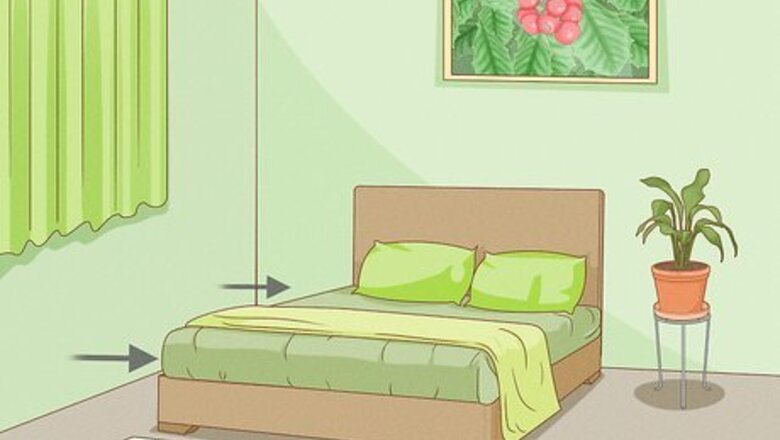
views
How do I permanently get rid of bed bugs at home?
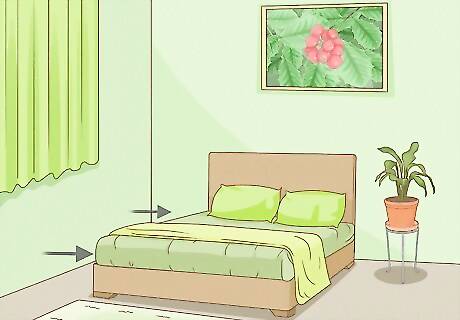
Move any beds away from the walls and wash the headboards. Slide your bed away from the wall to isolate your bed. Then, clean off the headboards with sudsy water to clear away any bed bugs still hanging around.

Vacuum your mattress, bed frame, box spring, and carpet. Clean your vacuum bag out. Then, get a thin hose attachment and vacuum everything. Go over each section of your mattress 2-3 times, along with the sides and base of your bed frame. Finish things off by vacuuming the floor and going over carpeted areas 2-3 times. This removes any adults that are hanging out around your bed. If possible, use a HEPA vacuum or vacuum bag. The bed bugs won’t be able to climb out of these bags after you suck them up. For an extra thorough clean, vacuum around the other parts of your room, like the walls, moldings, trim, and vents. Even your dresser drawers can benefit from a good vacuuming! Dump your vacuum bag or bagless vacuum contents in a sturdy plastic bag. Then, tape the bag shut and toss it in the trash.
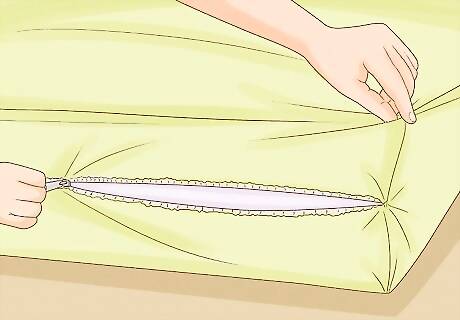
Suffocate the bed bugs with mattress covers and box spring covers. Slide your infested mattress and box spring into large, sturdy covers designed for bed bugs and/or dust mites. Seal these covers up tightly, inspecting them occasionally for tears. Patch up any tears with a strip of duct tape.

Wash and dry infested items on high heat. Stick any dirty and infested linens and clothes in your washer at 140 °F (60 °C). Then, transfer the washed items to your tumble dryer for a 20-minute cycle on really high heat. Use as many loads as necessary—this will kill any bed bugs and eggs in your clothes, blankets, and sheets. If your infested clothing or linens are already clean, stick them in the dryer rather than the washer.
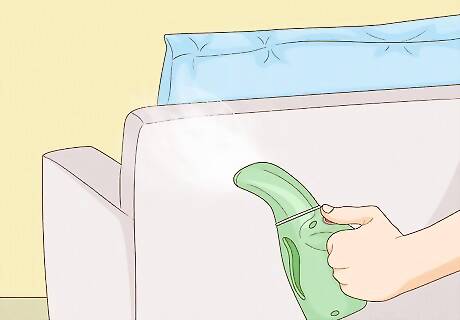
Steam-clean any infested furniture. Rent or buy a professional steam cleaner and use it on your armchairs, sofas, and other upholstered items. Move the steam cleaning nozzle slowly, taking 20 seconds to cover 1 ft (0.30 m) of space.
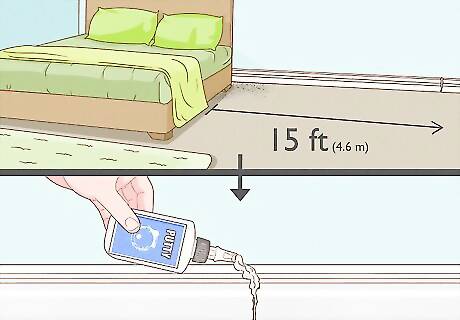
Seal any openings or cracks in the infested rooms. Inspect the surrounding walls for any openings or cracks that bed bugs could possibly enter through. Fill up these openings with a silicone-based sealant to keep more of the pests at bay. Any crack or crevice within 15 ft (4.6 m) of the main infestation point needs to be sealed up. Look for other small openings around your living space, like open screw or nail holes. Believe it or not, bed bugs can hide out there!
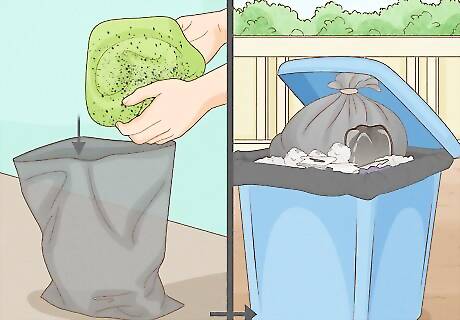
Throw out any infested items that aren’t salvageable. Is your couch still overrun with bed bugs after multiple rounds with the vacuum and steam cleaner? If so, it might be better to cut your losses and kick it to the curb—literally! Just be sure to destroy the item as much as you can so no one is tempted to grab it for themselves. Stick smaller, unsalvageable items in a sturdy plastic trash bag. Then, tape an “infested with bed bugs” label to the bag to give other people (like your neighbors and trash collectors) a head’s up. Spray “bed bugs” on bigger pieces of furniture with paint to really send the message home.
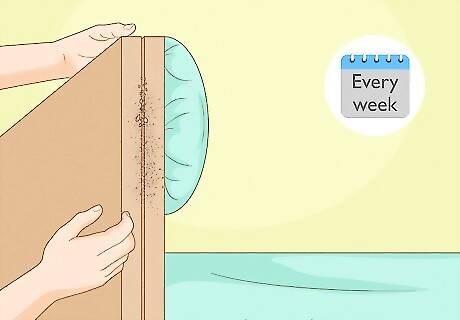
Check the infested rooms weekly to see if any progress is being made. Inspect the mattress, bed frame, and other bed bug hot spots to see if you notice any visible critters, skins, or staining. Bed bugs are persistent pests, so don’t be discouraged if you don’t see results immediately. Interceptors are a really handy way to keep tabs on your home’s bed bug status.

Call a pest control professional if the bed bugs don’t go away. Look online for pest control companies that have stellar reviews, and/or check with friends and neighbors for recommendations. Just keep in mind that professional bed bug extermination requires at least 2 treatments as well as a follow-up session—it isn’t a “one and done” deal. Pest control professionals have more thorough and effective extermination options to choose from, like heat treatment systems and pressurized CO2 snow.
Natural Ways to Get Rid of Bed Bugs

Freeze infested items for 3 days at 0 °F (−18 °C). Slide the items into a sealed plastic bags and stick them in the freezer. Cold temperatures don’t kill bed bugs right away, so keep your bags frozen for at least 3 days, to be safe. If your freezer only goes down to 32 °F (0 °C), keep the infested items in the freezer for 15-30 days.
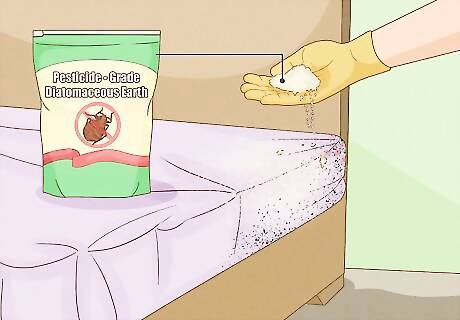
Sprinkle pesticide-grade diatomaceous earth around the infested area. Focus on the spots that bed bugs frequent the most, like around bed frames and inside wall crevices. Just keep in mind that diatomaceous earth isn’t an instant remedy—you’ll need to wait up to 2 weeks before seeing any results. Make sure that your diatomaceous earth is labeled specifically for insect/pesticide use. Food- and pool-grade varieties aren’t safe to breathe in, so you shouldn’t sprinkle them around your home. Always wear a mask when you sprinkle any diatomaceous earth around your home. Follow the directions on your package of diatomaceous earth to make sure you’re applying and cleaning it up properly.
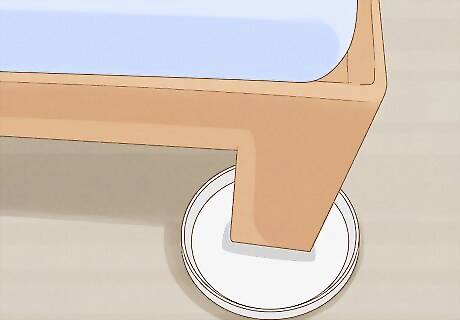
Set up bug interceptors around the infestation. Slide 4 interceptors or empty plastic containers beneath the 4 legs of your bed (or another piece of infested furniture). Then, pour a little bit of cooking oil into each dish. Keep an eye on these containers and see if they catch or “intercept” any bed bugs. If you’re using containers, make sure that they’re made with really sturdy plastic. If any of your traps crack or break under the pressure, switch them out with a solid replacement.
How can you tell if you have a bed bug infestation?
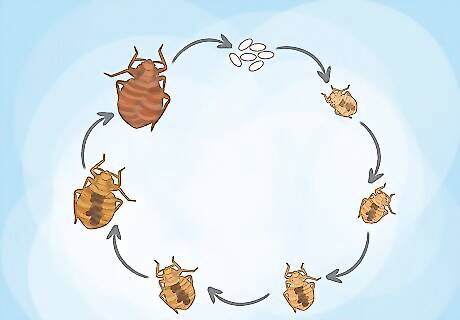
Look for live bugs, nymphs, and eggs. Fully-grown bed bugs are red-brown (occasionally bright red if they recently bit and fed on something). Bed bugs nymphs are a light yellow or white color (or super bright red after eating blood). The smallest and lightest of all, eggs are a translucent white color, developing reddish eyespots as they get older. Fully-grown, adult bed bugs are roughly apple seed-sized, while nymphs are smaller (but still possible to spot). Each bed bug egg is pinhead-sized. Adult bed bugs look bigger and rounder after feeding. A hungry, underfed bed bug looks flatter.

Molted skins and dung indicate a bed bug infestation. As bed bugs grow from nymphs to adults, they molt their outer exoskeletons. These molted skins are a honey-gold color, though they may range in size. Bed bug dung appears in clusters of round, black spots—they’re small, but still large enough to spot at a distance. Bed bug dung commonly pops up around mattress seams, mattress tags, baseboards, ceiling/wall seams, and power outlets. You might also spot them behind your bed’s headboard, along the very edge of your rug or carpet, or along the seam of a curtain, around the rod. Bed bugs often group up together after having a meal—these gatherings are known as “aggregations.” Aggregation spots are often filled with adult bed bugs, nymphs, eggs, dung, and molted skins.
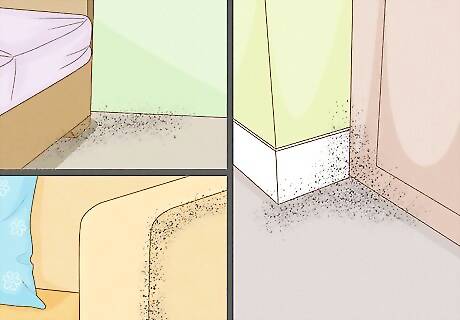
Search carefully around your bedroom to look for signs of bed bugs. Bed bugs notoriously love to hang out around mattresses and box springs, but they can pop up in a variety of different spots. Grab a flashlight and check: Around the bed: Inspect beneath the mattress and box spring, around your bed frame, and around your sheets and pillowcases. Furniture: Check out furniture that’s close to your bed as well as any other upholstered seats and couches in your home. Walls and floors: Inspect wall cracks, peeling wallpaper, baseboards, molding, floorboards, doorframes, window trim, window coverings, wall decorations, frames, mirrors, rugs, and electric sockets and other wall-mounted electronic devices. If you can’t identify any bed bugs with absolute certainty, carefully bag up a bug or molted skin and bring it to your county’s extension office. They can examine the specimen and confirm whether or not it’s a bed bug. Find your local extension office here: http://npic.orst.edu/pest/countyext.htm
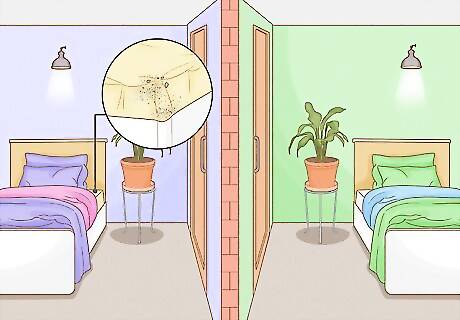
Check other rooms to see how far the bed bugs have spread. Inspect any nearby bedrooms and living spaces for visible bed bugs, eggs, and stains. You’ll need to clean out any area that’s potentially infested. If you don’t clean out every infested space, the bed bugs will continue to spread and be a nuisance around your home.
Ways to Prevent Bed Bugs

Organize and clear away any clutter in your home. Sort through any piles of clothing lying around the room, along with anything else that’s taking up space. Try to get rid of as much clutter as possible—the cleaner your home, the harder it is for bed bugs to hide away. Focus your cleaning efforts on rooms where bed bugs are especially likely to hide, like your bedroom.

Inspect any used furniture and/or clothing before bringing it inside. Bed bugs can easily get a ride into your home through old furniture, clothes, and other secondhand items. Check each item for bed bugs, stains, eggs, and/or dung. Leave any suspicious-looking items at the store instead of taking them home.
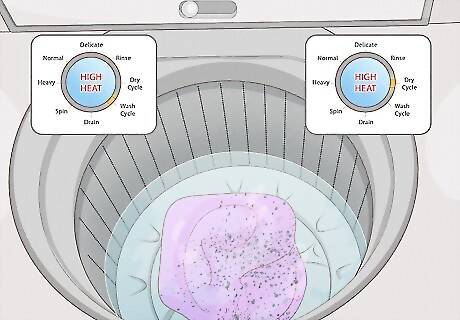
Wash and dry potentially infested items as soon as possible. Not sure if the motel bed you slept on had bed bugs? Play it safe by washing your clothes right away, using a high-heat wash and dry cycle. If you can’t wash your clothes right away, seal them up tightly in a plastic bag for the time being.
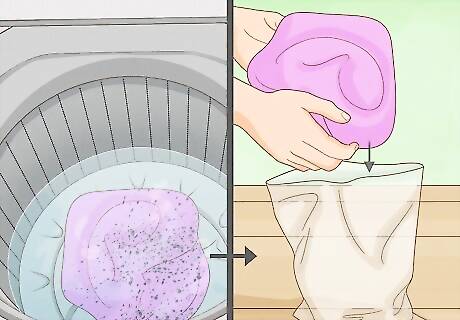
Store freshly-laundered clothes and bedding in plastic bins. Bed bugs aren’t a fan of plastic surfaces, which makes plastic bins the perfect way to protect your clothes and linens. Stash your sanitized sheets, clothes, and other items in plastic bins while you’re dealing with an infestation at home. Sealable plastic bags can also work in a pinch—just make sure that they’re labeled “heavy-duty.”
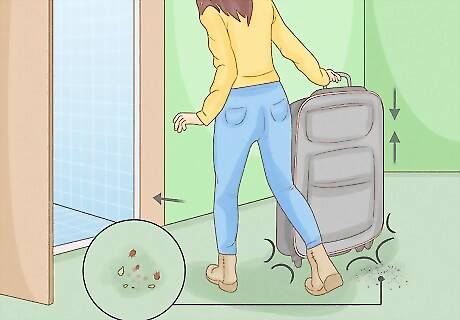
Take precautions while traveling so bed bugs don’t hop into your luggage. Stash your luggage in the bathroom when you first arrive; that way, bed bugs can’t sneak into your belongings from the nearby carpet, furniture, and bedding. Then, thoroughly inspect the luggage stand for critters, stains, or other telltale bed bug signs. If everything looks good, stick your luggage on the stand for the rest of your trip. Try to keep your luggage in your suitcase, too. Dressers can be a popular spot for bed bugs to hang out.
Bed Bug Bite Treatment

Wash the affected skin with soapy water. Soap and water help prevent the bites from getting infected. A quick but thorough wash can also help tone down the itchiness.
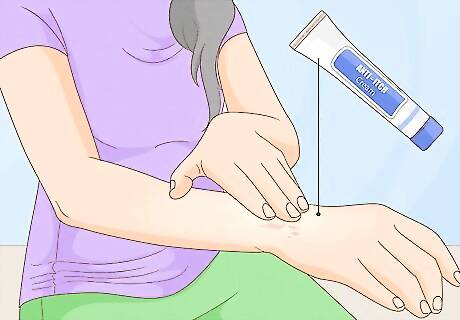
Treat itchy bites with anti-itch cream and/or allergy medication. Pick up a corticosteroid cream from your local pharmacy and rub it all over the itchy bites. Antihistamines like diphenhydramine (Benadryl) can also help treat bed bug bites. Shop for skin creams that are 1% hydrocortisone.
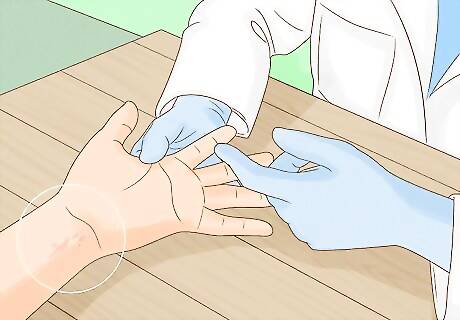
Visit your doctor or dermatologist if you have more severe symptoms. Many bed bug bites are treatable at home, but call a medical professional right away if you notice any blisters, hives, swelling, or discharge around the bites. A doctor or dermatologist can help treat any allergic reactions or skin infections. Antibiotics and antiseptic medications are common treatments for bed bug bite-related skin infections. If you’re having a severe allergic reaction, your doctor might inject you with epinephrine/adrenaline, an antihistamine, or a corticosteroid.













Comments
0 comment